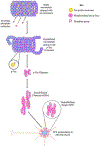Hyperphosphorylated tau (p-tau) and drug discovery in the context of Alzheimer's disease and related tauopathies
- PMID: 36634842
- PMCID: PMC9975055
- DOI: 10.1016/j.drudis.2023.103487
Hyperphosphorylated tau (p-tau) and drug discovery in the context of Alzheimer's disease and related tauopathies
Abstract
Alzheimer's disease (AD) is the most common form of dementia, characterized by intracellular neurofibrillary tangles (NFTs) and extracellular β-amyloid (βA) plaques. No disease-modifying therapy is currently available to prevent the progression of, or cure, the disease. Misfolded hyperphosphorylated tau (p-tau) is considered a pivotal point in the pathogenesis of AD and other tauopathies. Compelling evidence suggests that it is a key driver of the accumulation of NFTs and can be directly correlated with the extent of dementia in patients with AD. Therefore, inhibiting tau hyperphosphorylation-induced aggregation could be a viable strategy to discover and develop therapeutics for patients with AD.
Keywords: Alzheimer’s; amyloid; dementia; hyperphosphorylation; tau; therapy.
Copyright © 2023 Elsevier Ltd. All rights reserved.
Conflict of interest statement
Declaration of interests
None declared by authors.
Figures





References
-
- WHO. Global Action Plan on the Public Health Response to Dementia 2017–2025. Geneva; WHO: 2017.
-
- NIA. Alzheimer’s Disease Fact Sheet. www.nia.nih.gov/health/alzheimers-disease-fact-sheet [Accessed 3 January 2023].
Publication types
MeSH terms
Substances
Grants and funding
LinkOut - more resources
Full Text Sources
Medical

